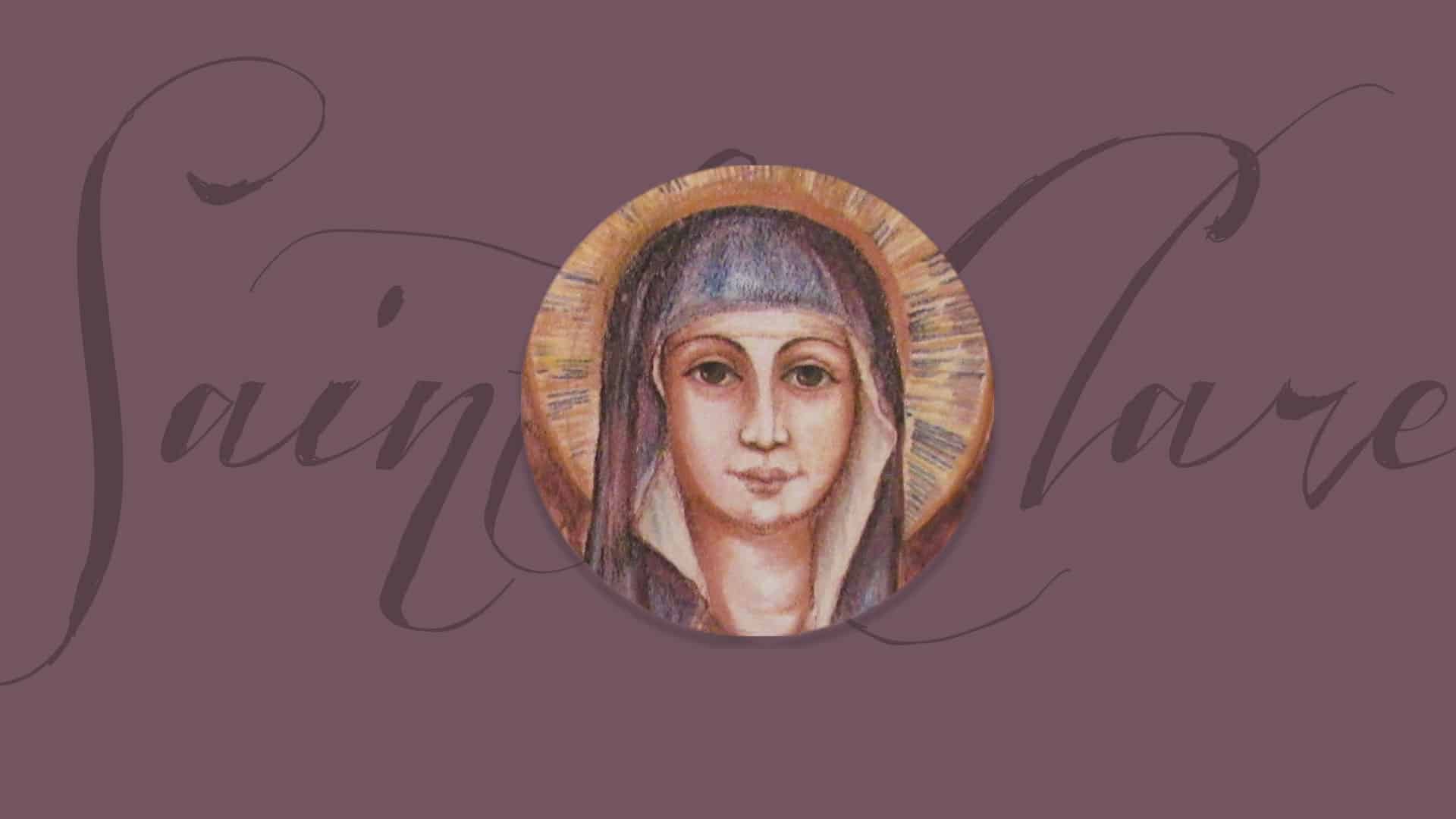Many people thought Clare of Assisi, a noblewoman, was wasting her life by living as a cloistered nun at San Damiano. She proved them wrong.
Throughout the world in 2012, the 800th anniversary of the founding of the Poor Clares is being celebrated. The simple life of St. Clare of Assisi, who lived in a small place outside Assisi’s medieval walls, still speaks to us. Why? Her spiritual quest resonates with our yearnings to live authentically from the fire of love within. Clare’s virtuous life made God’s love real to countless others. Many stories about her life encourage us to grow in holiness, to imitate her enthusiastic love.
On Palm Sunday 1212, worshipers at the Cathedral of San Rufino were joyfully anticipating Holy Week celebrations. After 10 years of war, Assisi’s citizens were looking forward to being reunited at their church. In the cathedral’s piazza after Mass, they were all abuzz over the most unusual behavior of Clare, daughter of Favarone and Ortulana.
Clare had not left her place to join the other elegantly dressed noblewomen receiving a palm from Bishop Guido. She seemed rapt in a dream. When the bishop left the sanctuary to give her a palm branch, they wondered: Was this part of the ritual? Why did Bishop Guido notice her? They could not have guessed that he was blessing her plan to abandon her home and dedicate herself to a life of radical poverty and prayer.
Leaving Behind a World of Privilege
Clare’s stealthy, nighttime departure from home had been thought through carefully. For a year she met secretly with Francis of Assisi to devise her exit strategy. A noblewoman, she was the firstborn daughter of the Offreduccio family, who resided next to the cathedral. Their castle windows overlooked Piazza San Rufino. Choosing not to marry, she rejected the expectation of her father and his knights that she would accept an arranged marriage to a suitable nobleman. Escaping the watchful eyes of the household required extensive and careful planning.
Clare’s spiritual journey to a penitential life had begun at home through ascetical practices, prayer, and acts of charity, especially contributing money and food to the poor. According to Beatrice, Clare’s sister, Francis heard about Clare’s reputation for holiness and spoke with her many times, encouraging her desire to renounce her wealth and status in order to serve God in a new way. These conversations confirmed his intuition that Clare could lead women who would live at the repaired church of San Damiano.
In 1205, Francis had responded to Christ’s call to rebuild that church on a hillside outside Assisi’s city walls. While working on the repairs, he prophesied in French, “Come and help me in the work of building the monastery of San Damiano, because ladies are yet to dwell here who will glorify our heavenly Father.” Since women were to live there, he built a dormitory over the church. The empty place awaited its community of holy women.
Under cover of darkness, Clare left her home, trusting absolutely that God would provide. What a radical decision: to reject marriage and to live without any material security because she chose to be in union with Jesus who had nowhere to lay his head! At least she would have this monastery at San Damiano. Even though it seemed absurd to imagine women choosing to live outside those sturdy, medieval city walls, Francis and Clare acted upon their divinely inspired messages. The Gospel of Jesus Christ guided their new way of life.
She and her companion left through the Moiano gate and were soon met by friars who led them to another small chapel in the valley, the Porziuncola. This chapel of Saint Mary of the Angels, her “little portion,” was the third church that Francis had repaired. There he had heard the Gospel of Luke speak very clearly: Proclaim the kingdom of God. . . . Take nothing for the journey. Inside the chapel, Francis cut off her hair, ritually declaring that she had left the world behind.
Clare and Francis knew that her family’s knights would try to bring her back. After all, her marriage would strengthen a military alliance with another noble family. Clare was resolved to remain a virgin.
Years later, Clare wrote to Agnes, princess of Bohemia, who had renounced marriage to both the Holy Roman Emperor, Frederick, and his son before entering the Poor Clare monastery that she had funded: “You took a spouse of a more noble lineage, who will keep your virginity ever unspotted and unsullied, the Lord Jesus Christ.”
On Monday of Holy Week, the friars accompanied Clare to the Benedictine monastery of the “abbesses,” only three kilometers away. Approaching this monastery in Bastia, Clare felt anxious. Uncertain when her absence would be detected, she knew that her Uncle Monaldo, head of the family household, would try to carry her back home.
What irony! Clare was condemned by her family and suffered their alienation while participating in Holy Week’s liturgies. Monaldo indeed led a contingent of knights who demanded that Bastia’s abbess allow them to visit Clare, whom they found in the chapel. Pulling back her veil, Clare exposed her tonsured haircut and then clung to the altar.
This action signaled that Clare had given herself to God as a consecrated virgin. Clinging to that altar invoked papal protection for anyone who entered this chapel to flee from violence. The knights left without Clare, who continued in her prayerful resolve to follow in the footsteps of Jesus Christ, living without a dowry, as had the Benedictine nuns.
Finding Greater Security
A week later, Francis, Philip, and Bernard accompanied Clare past Assisi and up to Sant’Angelo in Panzo. On the side of Mount Subasio, Clare temporarily lived at a villa with women penitents. Her dream of living a life of poverty in the footsteps of Jesus was coming true. Her feet seemed to skip with joy. The spring flowers were bursting with great fragrance under a warm sun. Clare’s spirits soared with new freedom. She had no weighty things to carry because she was following the poor Christ.
A few weeks later, Agnes, her sister, joined Clare; soon several other women arrived to form the nucleus of the community that settled into San Damiano the following September. She lived there until her death on August 11, 1253.
Written at the end of her life, Clare’s Testament recalls, “When the blessed Francis saw, however, that, although we were physically weak and frail, we did not shirk deprivation, poverty, hard work, trial, or the shame or contempt of the world—rather, we considered them as great delights . . . he greatly rejoiced in the Lord.”
Well Known for Her Holiness
In less than three months, Bishop Bartholomew of Spoleto recorded 20 eyewitness accounts of Clare’s holiness. Pope Innocent IV had requested that Bishop Bartholomew promote her canonization. In November 1253, the bishop and a small committee interviewed sisters who lived with Clare at San Damiano. Their stories and those of others comprise The Acts of the Process of Canonization, an invaluable source to become acquainted with Clare.
In the official life of Clare promulgated within three years of her death, the world learned of Clare’s healing touch: “The beloved Crucified took possession of the lover, and she was inflamed with such love of the mystery of the Cross that the power of the Cross is shown by signs and miracles.”
Clare’s reputation as a healer became widely known in the Umbrian valley. Mothers brought children to her with the hope that Clare’s practice of making the sign of the cross on the forehead of sick people would bring them healing. Knowing this, St. Francis sent her Brother Stephen, whom she cured of his madness. Many of the sisters who lived with Clare testified about the healings that happened at San Damiano through Clare’s touch.
The source of Clare’s healing power flowed from her contemplation of Jesus and meditation on the Gospels. Sister Benvenuta said, “Clare was very assiduous, day and night, in prayer.” Clare appropriated the graces of her Baptism to become one with Jesus so that through her the Gospel was proclaimed. “These signs will accompany those who believe: they will lay hands on the sick, and they will recover.”
Clare’s departure from her family’s castle exposed Assisi’s social unrest, caused by inequity of power and possessions. That social status determined one’s standing within the feudal system contradicted Jesus’ prayer that all may be one. Clare’s great love for Assisi and desire that fighting would stop is still recounted every June 22 with the festa del voto.
Assisians fondly recount the story of Clare, who in 1240 saw a group of mercenary soldiers approaching San Damiano Monastery, en route to Assisi. While she prostrated herself before the Blessed Sacrament to beg for divine protection, she heard a voice say, “I will always protect you.”
Clare arose from prayer, confidently assuring the sisters that they would be protected and that Christ said that the city of Assisi would “suffer afflictions, but will be defended by my protection.” And so it happened.
Living a vowed religious life requires a public commitment to consecrated celibacy within a community for the sake of the God quest. Clare’s steadfast conviction to live poorly without the backup security of landholdings such as other monasteries possessed was widely known; soon other women’s communities desired to live in a similar manner.
At first Clare was governed by Francis’ Form of Life (“to live according to the perfection of the holy Gospel”). Through her 40 years of life at San Damiano, she wrote a Form of Life for the Poor Ladies there, becoming the first woman to write a religious rule of life for women.
21st-Century Clare
Today a woman joining the Poor Clares, facing a radical departure from lay life into consecrated life, does not experience the external drama of a nighttime escape from home. However, the wrenching emotional detachment from family and peers along with the personal ownership of things, such as a home, car, or even a computer, requires the same discernment and firm conviction that Clare of Assisi showed.
A passion for God remains the only sustainable reason to join a community of celibate women whose personal and communal prayer forms the core of their lifestyle. The example of the joyful troubadour, Francis, and the prayerful healing power of Clare continue to challenge people today to examine how they follow the footprints of Jesus in today’s world.








